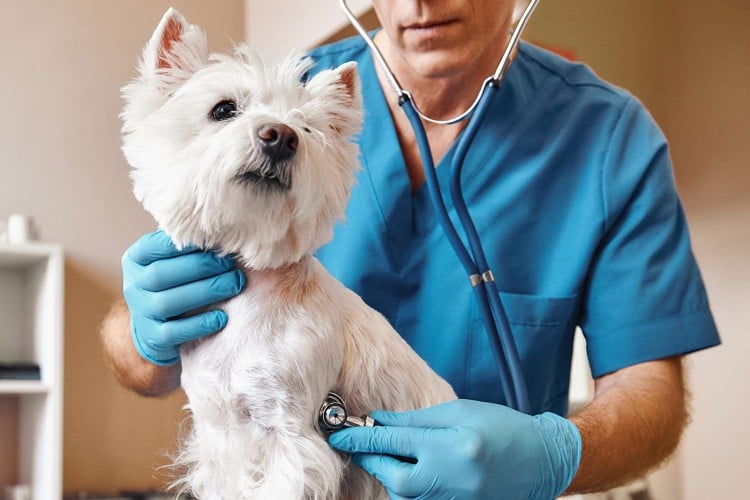Have you noticed your dog scratching frequently, shaking his head, or compulsively licking his paws? These are all signs of a pup who's dealing with discomfort. Yeast infections commonly cause these issues and tend to develop on the paws, in the ears, armpits, skin folds, and your dog's hind end. An overgrowth of yeast is considered a fungal infection because yeast is actually a type of fungus. It's not contagious, but it makes skin incredibly itchy and will get worse if it isn't treated.
What Causes a Dog Yeast Infection?
Malassezia is a type of yeast that naturally lives on a dog's skin, in his ears, and in his anal sacs. Normally, it's kept in check by a healthy immune system. When the yeast grows out of control, it irritates the skin and causes yeast dermatitis (inflammation of the skin).
Some dog breeds are more prone than others to yeast infections, including:
- Basset hounds
- Chihuahuas
- Dachshunds
- Lhasa apsos
- Poodles
- Shetland sheepdogs
- Shih tzus
- Spaniels
- Terriers
- West Highland white terriers
But they're not the only dogs who can get a yeast infection. In fact, any pup can get a yeast infection, which can be caused by something that lowers the immune system response or disrupts the skin's natural balance, causing yeast to multiply and spread. Common causes of yeast infections in dogs include:
- Allergies: The most common cause of a dog yeast infection is allergies to fleas, food, or substances in the environment. Allergies can lead to skin irritation and make skin oilier. Some dogs can also develop an allergic reaction to the yeast itself.
- Steroid Medications: Vets often prescribe steroid medications to treat dogs with autoimmune disorders and allergies. These conditions are an overreaction of the immune system. Steroids supress the immune system, so they can make dogs more susceptible to yeast infections. Their immune systems are less able to fight off germs.
- Antibiotics: Just like yeast, good bacteria are also naturally present on the skin. They help keep yeast levels in balance. Antibiotics wipe out all bacteria, both good and bad. With bacteria out of the way, yeast numbers can grow out of hand.
- Underlying Medical Conditions: Some medical conditions like diabetes and seborrhea oleosa (overproduction of oil on skin) create an environment that promotes yeast overgrowth.
Signs and Symptoms of a Canine Yeast Infection
Just like yeast infections for us humans, yeast infections can make your dog miserable. Incessant itching and scratching is a telltale sign your pup could be dealing with an overgrowth of yeast. Here are a few other signs your pup is feeling itchy in the early stages of a yeast infection:
- Biting an area (along with scratching and licking)
- Rubbing his body against furniture
- Shaking his head vigorously
- Tilting his head
- Scooting his butt along the carpet (more commonly caused by anal gland issues)
As the yeast infection progresses, you may also see the following symptoms:
- Red, irritated skin or rash
- Smelly odor
- Discharge from ears
- Sores from scratching
- Brown discoloration of nails
- Crusty lesions on skin
- Darkening or thickening skin (may look like elephant skin)
"Ear infections caused by yeast are very common," says Nancy Kelso, DVM, medical director of VCA Columbia Animal Hospital at Hickory Ridge in Columbia, Md. "But we also see yeast infections in skin folds, such as where the legs meet the body and around the face and neck as well as on the vulva, anus, and paws."
How Your Dog’s Yeast Infection is Diagnosed
The only surefire way to tell if your dog has a yeast infection is to take him to the vet. Your vet will take a sample from your dog's infected ear or skin by swab or scrape, with a piece of tape, or by simply pressing a microscope slide along the skin. Reviewing this sample under a microscope can reveal if your pup has yeast and how much of it there is.
In addition, your vet will analyze the sample for other issues. "Frequently, dogs with yeast also have bacterial infections or skin mites (mange)," Kelso says. "In these cases, treating only the yeast won't solve the problem."
How to Treat Your Dog’s Yeast Infection
There are two kinds of treatments for a dog yeast infection: antifungal pills and topical products like shampoos and ointments.
If the yeast infection is mild or limited to one or two small areas, topical treatment may be enough. But if the infection is severe or widespread, your dog may need oral medication. Your vet may also recommend a combination of treatments. Many dogs will benefit from medications to relieve itching and discomfort while the infection is clearing up.
Topical Treatment for Ear Yeast Infections
Once you've applied the liquid solution into your dog's ears, you'll massage the base of the ears to distribute the medicine. If your dog isn't too fond of the treatment, try distracting him with treats to help get the right amount of the liquid into the ears.
Topical Treatment for Skin Yeast Infections
Topical treatments for canine yeast infection on the skin include shampoos, ointments, and wipes. Kelso says that using them will typically involve a few steps:
Oral Treatment for Dog Yeast Infections
Kelso points out that sometimes topical medications just aren't effective, especially for dogs that hate bath time or have long, dense coats that make it hard to get topical treatments on the skin. In these situations, oral treatment may be the only option.
Taking an antifungal pill can also be better for more advanced yeast infection cases because it kills yeast fast. But prescriptions like ketoconazole, fluconazole, itraconazole, and terbinafine aren't without a downside—they can also cause stomach upset and affect the liver. According to Kelso, monitoring your pet with regular blood work is necessary during oral treatment.
Vet-Approved Tricks for Giving Your Pets Pills
The itch that was driving your pup nuts should get better within a week of treatment, but your vet may prescribe anti-itch medication like Apoquel to provide faster relief. Keep following your vet's treatment plan to make sure the infection doesn't come back. Fungal infections like yeast can be very persistent, and a full recovery may take several weeks or months.
How to Prevent Yeast Infections from Happening Again
Some dogs are prone to yeast infections—whether because of their breed or because of another medical condition. Good ear care at home can help prevent ear infections, so try to make it a habit of giving your pup regular ear washes with vet-approved over-the-counter products.
Since allergies can bring on yeast infections, it's important to address the signs of allergies when they first appear. Work with your vet closely to manage your dog's allergies. If you know that your dog suffers from seasonal allergies, talk to your vet about allergy management as that season approaches.
Considering a natural home remedy for your dog's yeast infection? They may work to help suppress yeast growth, Kelso says, but the best thing you can do for your pet is to figure out what caused the problem in the first place. Most acidic agents like vinegar can help slow yeast growth but don't kill it. "To prevent a recurrence, you have to identify and treat the underlying disease, such as allergies or diabetes," Kelso says. "It's just as important as treating the yeast." So while these at-home remedies can be useful in preventing yeast infections, they don't resolve them on their own.
In addition to vinegar, other herbal products like tea tree oil have mild antiseptic or anti-inflammatory properties which can help too—but be careful: tea tree oil is toxic to dogs. It should be diluted, only applied externally, and never put in a spot that your dog can lick.
As with any medical condition, your best bet is to consult your veterinarian who can help treat your dog's yeast infections safely and effectively.










Comments on " Could Your Dog Have a Yeast Infection? Here's What to Do" :